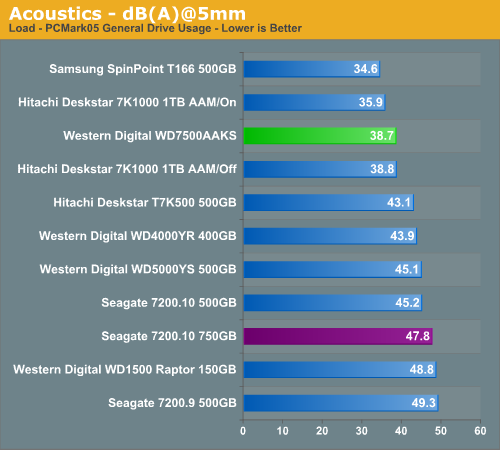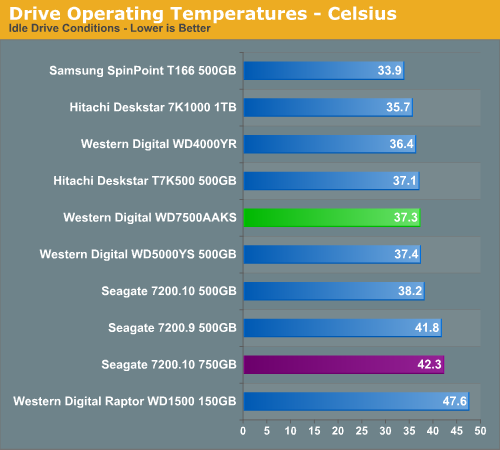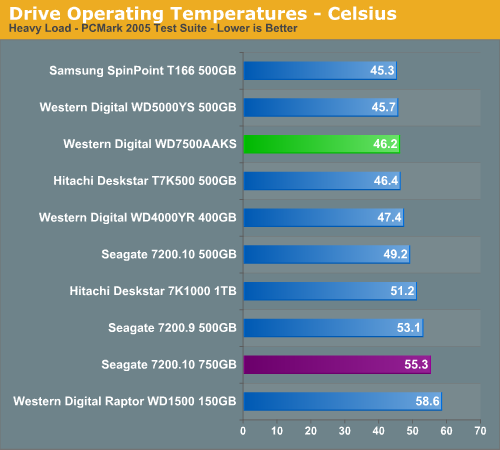Western Digital SE16 750GB: "Quiet" a Performer
by Dave Robinet on August 9, 2007 2:00 AM EST- Posted in
- Storage
Acoustics
Our acoustic test utilizes our standard test bed components but we implement Intel's power saving technology and turn off the case fans to eliminate as much case noise as possible during testing. Our Corsair power supply is nearly silent in these tests and our MSI 8800GTX video card is water cooled by an external pump/radiator unit to provide a further decrease in our case's ambient noise levels. Our drives are attached to the drive cage with rubber bushings to assist in isolating the noise of the drive and avoid the resulting harmonic changes due to the case design.
Our acoustic tests are designed to measure the decibel levels while the system is at idle and also under load while running the General Hard Disk Drive Usage benchmark within PCMark 2005. We found through trial and error that this particular benchmark produces controlled readings across a wide range of applications within the benchmark. This particular benchmark utilizes 60% reads and 40% writes within the trace playback file.
The measurements are taken at a distance of 5mm from the rear and front of the drive being tested in order to minimize surrounding environmental noise. We have noticed that unless we run a completely silent system in a quiet room that measurements taken from 1m are generally not meaningful because they are lost in the surrounding ambient noise. There are exceptions - like the Raptor series of drives - but overall most modern desktop drives are quieter now than the other components in the system.
The reported measurements are based on an A-weighted decibel score that measures frequencies similar to the way the human ear responds to sound. We take a total of three measurements for each test. We then subtract the high and low scores and arrive at our findings by reporting the remaining score. Our base dB(A) level in the room at time of testing was 25 dB(A).


Western Digital's claim of a quiet drive is indeed backed up by our acoustic measurements, though it cannot claim to be the quietest. Its idle noise measurement of just over 30dB(A) makes it a few decibels louder than both the Hitachi 7K1000 and the Samsung T166 drives which we've recently tested in the AnandTech labs. The score does represent nearly a 3 decibel reduction from any Western Digital drive we've previously tested, however, and easily bests the Seagate 750GB 7200.10.
The drive's activity measurements of 38.7dB(A) show the same pattern. The drive is still roughly 4 decibels louder than the whisper-quiet SpinPoint T166, but shows up substantially better than most other desktop drives in this class. The noise emitted by the drive during periods of activity can best be described as a low "thumping" or "pulsing" noise that was not obtrusive but noticeable at times.
Thermals
Our thermal tests utilize sensor readings via the S.M.A.R.T. (Self-Monitoring, Analysis and Reporting Technology) capability of the drives and are reported by utilizing the Active SMART 2.42 utility. We also utilize thermal sensors and infrared measurement devices to verify our results. We test our drives in an enclosed case environment without the fans operational to simulate temperatures that could conceivably be reached in a near silent SFF or HTPC case design. We typically find the reported numbers drop anywhere from 18% to 25% with the case fans operational. Our base temperature level in the room at the time of testing was 25C.


At 37.2C idle, the WD7500AAKS ends up in the middle of the pack. The situation improves dramatically, however, when the drive is under heavy load, coming in at an impressive 46.2C. This score is currently bested only by the Samsung T166 and the WD7500AAKS's smaller sibling, the 500GB WD5000YS. Keep in mind that larger drives with more platters usually generate more heat, so the temperature result is all the more impressive.
Our acoustic test utilizes our standard test bed components but we implement Intel's power saving technology and turn off the case fans to eliminate as much case noise as possible during testing. Our Corsair power supply is nearly silent in these tests and our MSI 8800GTX video card is water cooled by an external pump/radiator unit to provide a further decrease in our case's ambient noise levels. Our drives are attached to the drive cage with rubber bushings to assist in isolating the noise of the drive and avoid the resulting harmonic changes due to the case design.
Our acoustic tests are designed to measure the decibel levels while the system is at idle and also under load while running the General Hard Disk Drive Usage benchmark within PCMark 2005. We found through trial and error that this particular benchmark produces controlled readings across a wide range of applications within the benchmark. This particular benchmark utilizes 60% reads and 40% writes within the trace playback file.
The measurements are taken at a distance of 5mm from the rear and front of the drive being tested in order to minimize surrounding environmental noise. We have noticed that unless we run a completely silent system in a quiet room that measurements taken from 1m are generally not meaningful because they are lost in the surrounding ambient noise. There are exceptions - like the Raptor series of drives - but overall most modern desktop drives are quieter now than the other components in the system.
The reported measurements are based on an A-weighted decibel score that measures frequencies similar to the way the human ear responds to sound. We take a total of three measurements for each test. We then subtract the high and low scores and arrive at our findings by reporting the remaining score. Our base dB(A) level in the room at time of testing was 25 dB(A).


Western Digital's claim of a quiet drive is indeed backed up by our acoustic measurements, though it cannot claim to be the quietest. Its idle noise measurement of just over 30dB(A) makes it a few decibels louder than both the Hitachi 7K1000 and the Samsung T166 drives which we've recently tested in the AnandTech labs. The score does represent nearly a 3 decibel reduction from any Western Digital drive we've previously tested, however, and easily bests the Seagate 750GB 7200.10.
The drive's activity measurements of 38.7dB(A) show the same pattern. The drive is still roughly 4 decibels louder than the whisper-quiet SpinPoint T166, but shows up substantially better than most other desktop drives in this class. The noise emitted by the drive during periods of activity can best be described as a low "thumping" or "pulsing" noise that was not obtrusive but noticeable at times.
Thermals
Our thermal tests utilize sensor readings via the S.M.A.R.T. (Self-Monitoring, Analysis and Reporting Technology) capability of the drives and are reported by utilizing the Active SMART 2.42 utility. We also utilize thermal sensors and infrared measurement devices to verify our results. We test our drives in an enclosed case environment without the fans operational to simulate temperatures that could conceivably be reached in a near silent SFF or HTPC case design. We typically find the reported numbers drop anywhere from 18% to 25% with the case fans operational. Our base temperature level in the room at the time of testing was 25C.


At 37.2C idle, the WD7500AAKS ends up in the middle of the pack. The situation improves dramatically, however, when the drive is under heavy load, coming in at an impressive 46.2C. This score is currently bested only by the Samsung T166 and the WD7500AAKS's smaller sibling, the 500GB WD5000YS. Keep in mind that larger drives with more platters usually generate more heat, so the temperature result is all the more impressive.










37 Comments
View All Comments
retrospooty - Thursday, August 9, 2007 - link
"There seems very little reason to even consider a Raptor anymore. "Except for hte fact that the Raptor 150 is 1 1/2 years old (thats older than the 7200.10 you mentioned) and a 300g Raptor, hopefully with 32m cache is also right around the corner. A300g Raptor with 32m cache will once again own the retail sector by a wide margin.
mostlyprudent - Thursday, August 9, 2007 - link
It will be interesting to see what new Raptor with 32MB of cache can do. I am still skeptical whether it will be able to manage the kind of performance advantage the Raptors had when they were first introduced. I personally think WD will have a tough time charging a significant price premium over other 300GB drives, let alone 750GB and 1TB drives.yyrkoon - Monday, August 13, 2007 - link
You mean the 'whopping' 58MB/s average ? The raptors when first released had issues. Less so now, and they perform much better. Not good enough to justify the cost in my opinion, but whatever floats your boat . . .
ceefka - Friday, August 10, 2007 - link
The Raptor would need more than 32MB cache to get (far) ahead of the pack again, like it did when it was first introduced. Three things they can do:1. Higher density platter :perpendicular
2. 15K rpm? I don't even know if that is possible, but it would be cool.
3. Like you said: 32MB or even more cache.
Martimus - Wednesday, August 15, 2007 - link
The higher density would slow it down, because the heads would need to be more precise. I think that is why the raptors always have less capacity than their caviar brand.retrospooty - Friday, August 10, 2007 - link
Right now the Raptor 150 is ahead of the pack with 16m cache vs 32, and a much lower density per platter, and no perpendicular storage. Add those 3 things and we might be cooking. I have heard rumors that 15k is in the works, but not confirmed.Basilisk - Thursday, August 9, 2007 - link
Or, you may need something loud enough to drown-out your partner's snoring. :)yyrkoon - Monday, August 13, 2007 - link
Funny that, I own a 750GB Seagate, the computer sits less than 4 feet from my head when I sleep up on a desk, and I cannot hear it. Now, If it were not the end of summer, and I were not living in the desert, had all my fans off, I MAY hear the occational disk chatter, but I'll be dahmed if it would ever keep me awake . . .Sometimes I wonder about some of you guys . . .
retrospooty - Thursday, August 9, 2007 - link
??? I dunno. I see AT's comparison always has the Raptor being loud, but I hafve had 1 36g 2 75g and 2 150g Raptors, none of them have been noisy at all, not even compared to other drives. Was I just lucky or is AT's samples unlucky?semo - Thursday, August 9, 2007 - link
is there a difference between the serial ata and the pata se16 wd drives?